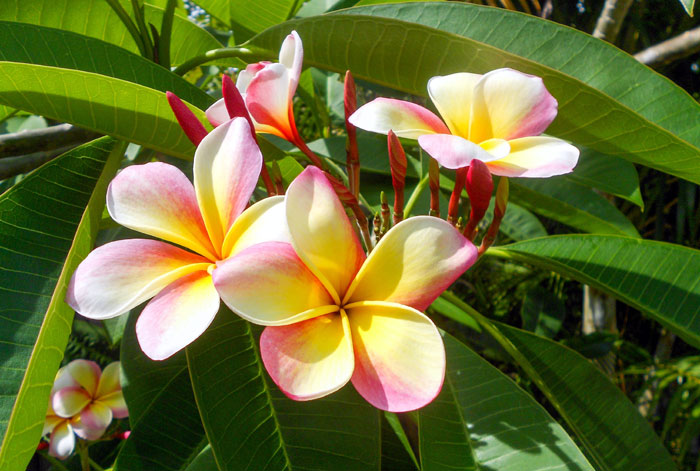Plumeria (Frangipani)
Plumeria is one of the most beautiful and fast-growing tropical-flowering plants. Such plants can be kept in the house, indoors or outdoors, depending on the situation. This plant can grow up to 30 feet depending on maturity. It grows extremely well in hot climates. It tastes flowers consistently from March to October. Many people know it by the name of frangipani, it is very sensitive to cold, so plants thrive very well in summer. If your area dips below 30 degrees F, make sure it’s safe.

Overview Frangipani
Scientific name Plumeria Rubra
Common name Plumeria, Frangipani, milk tree
Plant type Flower
Sun requires Full Sun, Part Sun
Blooming time March to October
Flower colors White, Yellow, Orange, Salmon, Pink, and Red
Soil well-drained, slightly acidic
Soil pH 6.4-6.8
Zone 9-11
Common name
Generally, it is called white Frangipani, pagoda tree, caterpillar tree, and milk tree. Most names have been kept on its white flowers and the substances like milk coming out, Which turns out to cut its leaves and branches. Read more.
How to grow Plumeria
Soil and location
A good and well-draining soil that is slightly acidic is best for growing Plumeria plants. Use a potting mix with sand and organic manure. Plumeria plants, like most flowers, need full sun. During the summer, you can move your container to a shaded area in the afternoon.
Propagation
Growing Plumeria is easiest through cuttings. The best time to take a cut is from February to March. Cut 4-6 inch sections from the tips of shoots with a clean knife. Let the cutting dry for two days, then plant it in a pot with good potting soil. Cover the cutting with a polythene sheet and place it near a radiator or in a warm spot.
Watering
Watering During the summer, water your Plumeria plants deeply at least twice a week. Make sure to water your potted plants regularly, as they dry out faster than plants in the ground. Be cautious about overwatering, as it can cause the plant’s trunk to rot. In the middle of the fall, reduce the amount of water for your Plumeria plants, as they begin to go dormant.
Fertilizing
Plumeria plants perform well with high levels of phosphorus fertilizer if you use 10 -15 -10 (NPK) then it is better. Fertilize your plant during the growing season in spring. In August, apply to encourage Hawaiian Bud & Bloom every 2-3 weeks, its flowers grow to decorate your garden from summer to fall.
Frangipani care
- Frangipani plants are hardy and easy to care for. You can get healthy plants with little care.
- This plant grows well in sunlight, so place it where there is more sunlight.
- Overwatering can be dangerous for these plants.
- Fertilize it with 10-15-10 (NPK) every two weeks, it will stimulate its bloom.
- If more important, then sort out the plant but it is very harsh and can reduce the production of flowers.
- Plumeria rust (orange powder) disease can be found in the plant which covers the leaves. Use any of the fungicides when there is a problem.
Pruning milk tree
Sorting is necessary for the Plumeria plants to give the proper size. Apart from this size, it develops new branches of the plant and there is more blooming. Pruning can be done in late winter or early spring. Cut the right upper part of the node slant with the help of a sharp knife. pruning is better to sort about 20 percent of the mature plant every few years; It opens the branches, and the sunlight comes in. It reduces stem rot disease.
Pests and disease
Plumeria rust (orange powder) usually appears sometime before the leaves fall, and it appears as disintegration on the leaves, spray it with the appropriate fungicide. Remove the fallen leaves immediately and destroy them. There is also an outbreak of scale insects on its trunk or leaves. They look like small white or brown lumps. It is possible to treat it with suitable horticultural spray oil.
Whiteflies and mealybugs can also become a tree problem, you can protect against any good pesticides or organic methods. However, there is no major problem with insects in this tree.
Growing Plumeria cuttings
- The best time to grow Plumeria cutting is in spring. During this season you cut healthy stems of the plant that is new growth about 12 inches or more. Put the cutting inside the house for three to seven days to recover and heal, now it is ready to be planted.
- Apply the rooting hormone at the lower part of the cutting and let it sit.
Gravel or broken pieces of pot should be placed on the lower surface of the pot. Equal parts of perlite and sand should be mixed with a commercial potting mix. - Fill three-quarters of the 1-gallon pot with the prepared mixture. Add water to the filling mixture, until it starts moving out of the drainage hole in the surface.
- Fill about 3 inches of cut in the potting mixture and settle down that soil well.
- Put your pot under light shade for two weeks, then you can place it into the full sun area. When the running temperature is below 65 degrees Fahrenheit, it is better to put the pot indoors.
Caring for plumeria in pot
- It occurs approximately two or three months after planting. Put your finger in the soil and observe and pour water when the soil is dry.
- After developing the root system, place the pot directly in the sun. Water it regularly in the summer months.
- Fertilize liquid fertilizer during the Growing Period, use 10-15-10 NPK Fertilizer every 2-3 weeks.
- Do not prune the immature flower, it puts stress on the root system of the plant and can cause the plant to die.
- When the plant reaches the dormancy period, its leaves fall, at that time you bring it to the shelter area and avoid Do to water or fertilize. When new leaves appear, then start watering and fertilizing it.
- Put a stake on the edge of the pot. Which touches the pot surface, then binds it to a twine, from which frangipani did not move from its place.
- Set your pot to light shade for two weeks, and then move it to the full sun area, when the temperature is below 65 degrees Fahrenheit, take the pot inside. Read more.
Read also: How to grow Jade Plant. How to grow Cantaloupe in containers. . 8 Frugal Gardening tips. Peppercorns Growing and caring tips. Pansy flowers growing and care guide. Growing Anthurium plant indoors. Onion Growing and caring tips. Houseplants care tips. Growing Lily in containers. Kidney beans growing and caring guide. Impatiens growing and caring guide. Cloves tree growing at home. Soybeans growing and caring guide. Mulberry growing and care tips.
Happy gardening
For pin:






